Related Research Articles

Raj Kapoor, also known as Ranbir Raj Kapoor, was an Indian actor, film director and producer, who worked in Hindi cinema. He is considered one of the greatest and most influential actors and filmmakers in the history of Indian cinema, and has been referred to as The Greatest Showman of Indian Cinema and as the Charlie Chaplin of Indian Cinema.

The Dadasaheb Phalke Award is India's highest award in the field of cinema. It is presented annually at the National Film Awards ceremony by the Directorate of Film Festivals, an organisation set up by the Ministry of Information and Broadcasting. The recipient is honoured for their "great and outstanding contribution to the growth and development of Indian cinema" and is selected by a committee consisting of eminent personalities from the Indian film industry. The award comprises a Swarna Kamal medallion, a shawl, and a cash prize of ₹1,000,000 (US$12,000).
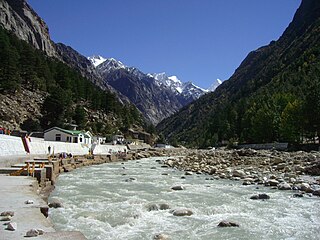
The Bhāgīrathī is a turbulent Himalayan river in the Indian state of Uttarakhand, and one of the two headstreams of the Ganges, the major river of Northern India and the holy river of Hinduism. In the Hindu faith, history, and culture, the Bhagirathi is considered the source stream of the Ganges. However, in hydrology, the other headstream Alaknanda, is considered the source stream on account of its great length and discharge. The Bhagirathi and Alaknanda join at Devprayag in Garhwal and are thereafter known as the Ganges.
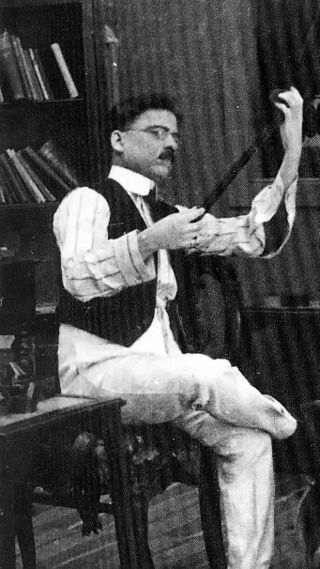
Dhundiraj Govind Phalke, popularly known as Dadasaheb Phalke, was an Indian producer-director-screenwriter, known as "the Father of Indian cinema".

Pran Krishan Sikand Ahluwalia, better known by his mononym, Pran, was an Indian actor, known as one of the greatest villains ever in the history of Indian cinema and a character actor in Hindi cinema from the 1940s to the 1990s. He has been one of the most highly successful and respected veteran actors in the history of Indian cinema. He was also one of the highest-paid actors of his time.
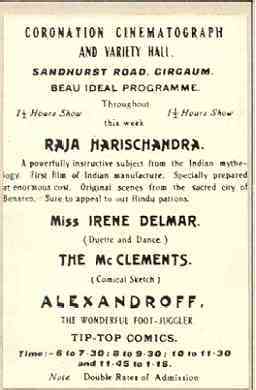
Raja Harishchandra is a 1913 Indian silent film directed and produced by Dadasaheb Phalke. It is often considered the first full-length Indian feature film. Raja Harishchandra features Dattatraya Damodar Dabke, Anna Salunke, Bhalchandra Phalke. and Gajanan Vasudev Sane. It is based on the legend of Harishchandra, with Dabke portraying the title character. The film, being silent, had English, Marathi, and Hindi-language intertitles.

Ganga is the personification of the river Ganges, who is worshipped by Hindus as the goddess of purification and forgiveness. Known by many names, Ganga is often depicted as a fair, beautiful woman, riding a divine crocodile-like creature called the makara.

Gulzar is an Indian Urdu poet, lyricist, author, screenwriter, and film director known for his works in Hindi cinema. He is regarded as one of greatest Urdu poets of this era. He started his career with music director S.D. Burman as a lyricist in the 1963 film Bandini and worked with many music directors including R. D. Burman, Salil Chowdhury, Vishal Bhardwaj and A. R. Rahman. Gulzar also writes poetry, dialogues and scripts. He directed films such as Aandhi and Mausam during the 1970s and the TV series Mirza Ghalib in the 1980s. He also directed Kirdaar in 1993.
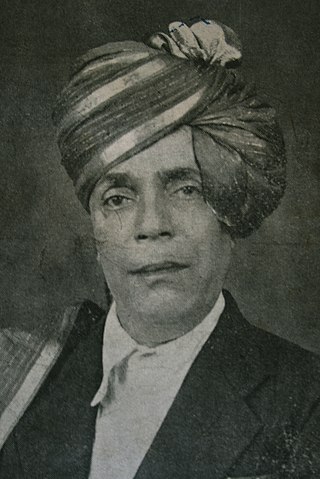
Vishwanath Jadhav (1885−1964) was an Indian classical khyal singer and a disciple of Abdul Karim Khan, the founder of Kirana gharana.
Satyavadi Raja Harishchandra is a 1917 silent black and white Indian short film directed and produced by Dhundiraj Govind Phalke. The film is a shorter version of the first Indian feature film, Raja Harishchandra (1913), also directed and produced by Phalke. The intertitles used in the film were in Marathi language as the film was a silent film. The film is based on the mythological story of a Hindu King Harishchandra, the 36th king of the Solar Dynasty, who donated his entire kingdom and sold himself and his family to keep the promise given to the sage Vishvamitra in the dream.

Lanka Dahan is a 1917 Indian silent film directed by Dadasaheb Phalke. Phalke also wrote the film based on an episode of the Hindu epic Ramayana, credited to Valmiki. The film was Phalke's second feature film after the 1913 Raja Harishchandra, which was the first Indian full-length feature film. Phalke also directed various short films in between.
Mohini Bhasmasur is a 1913 Indian mythological film directed by Dadasaheb Phalke and starring Kamlabai Gokhale and Durgabai Kamat. It is India's and Phalke's second full-length feature film. Mohini Bhasmasur is the first Indian film to have a female actor. In Raja Harischandra, India's and Phalke's first film, the role of the female was played by Anna Salunke, a male.
Radhu Karmakar was a noted Indian cinematographer and director in Hindi cinema from the 1940s to 1990s. He worked extensively with director-actor Raj Kapoor on his films and for his R. K. Studio. Starting with Awaara (1951), he shot all of Kapoor's subsequent films for four decades, till his last, Ram Teri Ganga Maili (1985).
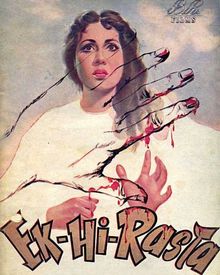
Ek Hi Raasta is a 1956 family-drama Indian Hindi film directed and produced by B. R. Chopra. It starred Sunil Dutt, Meena Kumari, Ashok Kumar, Daisy Irani, Jeevan and Shrinath in main roles. The music for the film was scored by Hemanta Mukherjee. Having directed a few films earlier, Chopra formed his own production house B.R. Films in 1955 and Ek Hi Raasta was the first film produced under this banner. The film was remade in Telugu as Kumkuma Rekha (1960) and in Tamil as Pudhiya Pathai (1960).
Narasinha Avatar is a 1949 Hindi mythological film produced and directed by Sohrab Modi. Made under the Minerva Movietone banner, it had music composed by Vasant Desai with lyrics by Narendra Sharma. The story was written by S. A. Shukla, and the film starred Mahipal, Shobhana Samarth, Niranjan Sharma, Hari Shivdasani, Tiwari, S. N. Tripathi and Kamal.
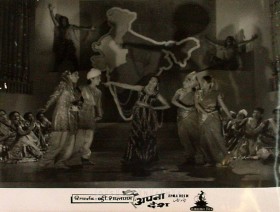
Apna Desh is a 1949 Hindi social drama film set against the backdrop of Partition and directed by V. Shantaram for his Rajkamal Kalamandir banner.

Trilok Kapoor was an Indian actor and a member of the Kapoor family who worked in Bollywood films. He was the younger brother of actor Prithviraj Kapoor.
Major Chandrakanth is a Tamil-language play written by K. Balachander and staged in the 1960s. It was adapted into a Hindi film titled Oonche Log in 1965, a Tamil namesake film in 1966, a Telugu film titled Sukha Dukhalu in 1968, a Malayalam film titled Karthavyam in 1982, and a Kannada film titled Karune Illada Kanoonu in 1983.

In Hinduism, rivers are often personified as deities. In the Rigveda, there are mentions of holy rivers such as the Sarasvati. The river Ganges is considered to be most sacred, and is also personified as the goddess Ganga. Most of the rivers are represented in female form, with the notable exception of Brahmaputra, which is considered to be male. Historically, it is believed that the people of the Indus Valley civilisation worshipped the rivers. The most significant rivers in the faith are the Saptanadi and which includes the Ganges, Yamuna, Sindhu, Narmada, Godavari, Krishna, and Kaveri.
Bishwanath Prasad Shahabadi,, also known as B.P. Shahabadi, was an Indian film producer and businessperson known for producing Bhojpuri and Hindi films. He is known as the father of Bhojpuri cinema. He gained prominence by producing the first black-and-white Bhojpuri film, Ganga Maiyya Tohe Piyari Chadhaibo, in 1962. Shahabadi's notable works include Solaho Singar Kare Dulhaniya (Bhojpuri) and Hindi films like Rootha Na Karo, Ganga Dham, Geet Ganga, Sasural and Tulsi and Ghar Jamai. He passed away on July 13, 2000.
References
- ↑ Eric Mazur (8 March 2011). Encyclopedia of Religion and Film. ABC-CLIO. p. 75. ISBN 978-0-313-33072-8 . Retrieved 23 February 2012.
- 1 2 The India magazine of her people and culture. A. H. Advani. 1997. p. 13. Retrieved 23 February 2012.
- ↑ Bāpū Vāṭave (1 January 2004). Dadasaheb Phalke, the father of Indian cinema. National Book Trust. p. 115. ISBN 978-81-237-4319-6 . Retrieved 23 February 2012.
- 1 2 Vinayak Purohit (1986). Arts of transitional India twentieth century. Popular Prakashan. p. 947. ISBN 978-0-86132-138-4 . Retrieved 23 February 2012.
- ↑ Bimal Mukherjee; Sunil Kothari; Ananda Lal; Chidananda Das Gupta; Anamika Kala Sangam (1995). Rasa: Theatre and cinema. Anamika Kala Sangam. p. 227.
- ↑ Encyclopædia Britannica (India) Pvt. Ltd; Gulzar; Govind Nihalani; Saibal Chatterjee (2003). Encyclopaedia of Hindi cinema. Popular Prakashan. p. 76. ISBN 978-81-7991-066-5 . Retrieved 23 February 2012.